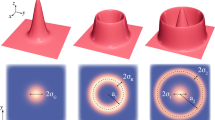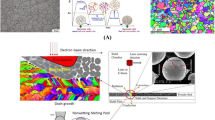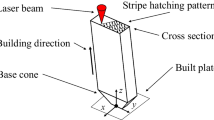Abstract
This paper introduces an iterative process-material analysis approach, to predict the evolution of grain size on the surface of a workpiece material, resulting from the mechanical and thermal loading effects during the machining process. The proposed approach endeavors to describe the effects, the resulting changes of the workpiece properties have on the process behaviors. The retroactive mechanism, in the context of how process behaviors are affected by material-microstructural variations, is jointly considered, while both mechanisms of grain refinement, as a result of dynamic recrystallization and grain growth due to thermal energy, are incorporated in the analysis of the final grain size. The dynamic recrystallization process is described by a Zener-Hollomon-based model. Furthermore, the thermal energy dissipation effect is quantified by a thermally activated cross-slip mechanism contributing to the increase of grain size. Subsequently, the outputs of these process mechanics, such as the strain, strain rate, and temperature, are calculated, and the microstructure behavior is predicted in response to the material properties and machining parameters. The experimental validations of the proposed approach are accomplished on two aluminum systems, AA7075 and AA 6061.
Similar content being viewed by others
References
Rotella G, Dillon OW Jr, Umbrello D, Settineri L, Jawahir IS (2013) Finite element modeling of microstructural changes in turning of AA7075-T651 alloy. J Manuf Process 15(1):87–95
Guo Y, Saldana C, Compton WD, Chandrasekar S (2011) Controlling deformation and microstructure on machined surfaces. Acta Mater 59(11):4538–4547
Fergani O, Shao Y, Liang SY (2014) Effect of temperature on the subsurface microstructure and mechanical properties of AA 7075-T6 in machining. Procedia CIRP 13:181–185
Abolghasem S, Basu S, Shekhar S, Cai J, Shankar MR (2012) Mapping subgrain sizes resulting from severe simple shear deformation. Acta Mater 60(1):376–386
Brinksmeier E, Gläbe R, Klocke F, Lucca DA (2011) Process signatures—an alternative approach to predicting functional workpiece properties. Procedia Eng 19:44–52
Fergani O, Liang SY (2013) Materials-affected manufacturing. Manuf Lett 1(2–4):74–77
Oxley PLB (1961) Mechanics of metal cutting. Int J Mach Tool Des Res 1(1–2):89–97
Fergani O, Shao Y, Lazoglu I, Liang SY (2014) Temperature effects on grinding residual stress. Procedia CIRP 14:2–6
Shankar MR, Chandrasekar S, Compton WD, King AH (2005) Characteristics of aluminum 6061-T6 deformed to large plastic strains by machining. Mater Sci Eng 410–411:364–368
Yanagimoto J, Karhausen K, Brand AJ, Kopp R (1998) Incremental formulation for the prediction of flow stress and microstructural change in hot forming. J Manuf Sci Eng 120(2):316–322
Lee W-S, Sue W-C, Lin C-F, Wu C-J (2000) The strain rate and temperature dependence of the dynamic impact properties of 7075 aluminum alloy. J Mater Process Technol 100:116–122
Nes E (1997) Modelling of work hardening and stress saturation in FCC metals. Prog Mater Sci 41:129–193
Shewmon PG (1964) The movement of small inclusions in solids by a temperature gradient. Trans Metall Soc AIME 230:1134–1137
Reed-Hill RE (1972) Physical metallurgy principles. Van Nostrand, New York
Sheppard T, Tunnicliffe PJ, Patterson SJ (1982) Direct and indirect extrusion of a high strength aerospace alloy (AA 7075). J Mech Work Technol 6(4):313–331
Fergani O, Tabei A, Garmestani H, Liang SY (2014) Prediction of material microstructural texture evolution in machining via viscoplastic self-consistent modeling. SME J Manuf Process 16:543–550
Tabei A, Fergani O, Garmestani H, Liang SY (2014) Analysis of micro-texture and grain size distributions in machined aluminum alloy 7075. Adv Mater Res 1052:489–494
Fergani O, Mkkadem A, Lazoglu I, Mansori M, Liang SY (2014) Analytical modelling of residual stress and the induced deflection of a milled thin plate. J Adv Manuf Technol 75(1–4):455–463
Ding L, Zhang X, Liu CR (2014) Dislocation density and grain size evolution in the machining of Al6061-T6 alloys. J Manuf Sci Eng 136(4):041020–10. doi: 10.1115/1.4027675
Author information
Authors and Affiliations
Corresponding author
Rights and permissions
About this article
Cite this article
Fergani, O., Liang, S.Y. The effect of machining process thermo-mechanical loading on workpiece average grain size. Int J Adv Manuf Technol 80, 21–29 (2015). https://doi.org/10.1007/s00170-015-6975-8
Received:
Accepted:
Published:
Issue Date:
DOI: https://doi.org/10.1007/s00170-015-6975-8




